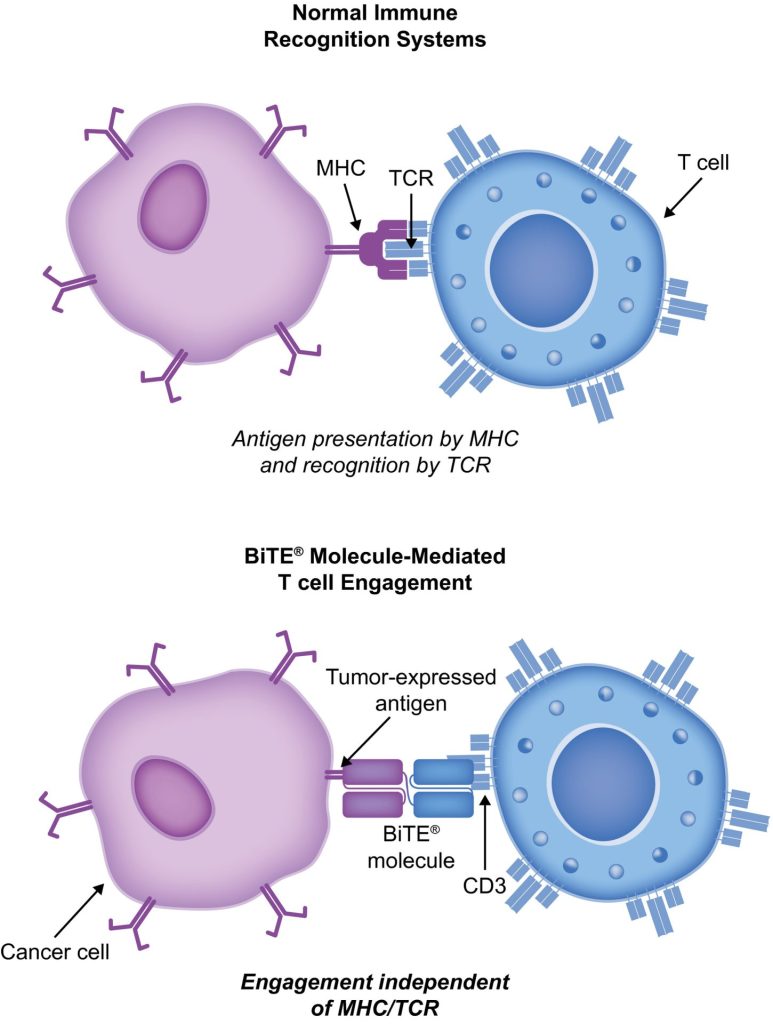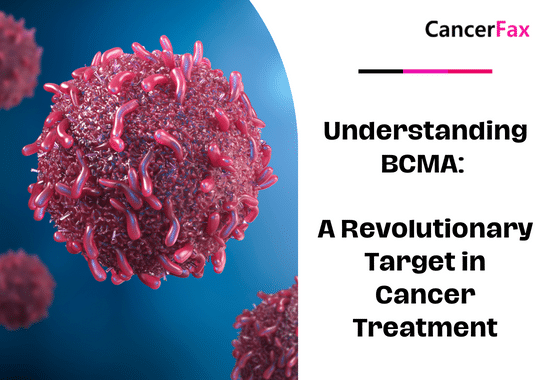Immuno-oncology is a way to treat cancer by using the body’s immune system. BiTE (bispecific T-cell engager) technology is a targeted immuno-oncology platform that binds a patient’s own T cells to cancer cells. Because BiTE technology is flexible, it is easy to make molecules that attack tumor-specific antigens, which makes immuno-oncotherapy possible. Blinatumomab was the first standard BiTE molecule to be approved. It targets CD19 surface antigens on B cells and is mostly unaffected by genetic changes or escape mechanisms inside cells. More BiTE molecules are being made to treat other blood cancers (like multiple myeloma, acute myeloid leukaemia, and B-cell lymphome non hodgkinien) and solid tumours (like prostate cancer, glioblastoma, stomach cancer, and small-cell lung cancer). BiTE molecules that have a longer half-life than the standard ones are also being made. With BiTE technology, advances in immuno-oncology could make it easier to treat both blood and solid tumours and make them more effective when used with other treatments.
Qu'est-ce que la thérapie BiTe ?
Immuno-oncology therapies are scientifically proven ways to treat different types of solid and cancers du sang. Hematologic cancers are a good fit for treatments that target the immune system because cancerous blood cells move around with immune cells. Several immunothérapie des traitements contre le cancer sont en préparation.
Monoclonal antibody checkpoint inhibitors that stop the binding of checkpoint proteins (like PD-1 and CTLA-4) are useful against many types of cancer. They work well and are safe for many solid tumours, especially when they target PD-1. Non-small-cell lung, kidney, and bladder cancers have all been treated successfully with these drugs. But many people don’t react to checkpoint inhibitors or get sick again after taking them. Except for non-Hodgkin lymphome, most results on hematologic cancers have been disappointing, especially for myeloma and leukaemia, where the overall response rate in approved indications ranges from 12.0% to 48.5%.8-15.
Other immuno-oncology treatments, on the other hand, have a higher success rate. Chimeric antigen-receptor (CAR) T-cell therapies change a patient’s T cells to attack a specific cellular antigen, such as CD19 in the treatment of B-cell malignancies and B-cell maturation antigen (BCMA) in the treatment of le myélome multiple (MM). CAR T-cell treatments have shown promise in treating hematologic cancers. They haven’t been as effective in treating solid tumours, but there have been some good results with neuroblastome, human epidermal growth factor receptor tumours, and non-small-cell lung cancer. The genetic modification and in vitro multiplication of T cells take a long and complicated manufacturing process. This is a downside of this therapy because it makes it harder for patients to get this treatment quickly and in large numbers. The fact that lymphodepletion through chemotherapy preparation must be done first as a requirement for improved effectiveness is also a drawback.
Les thérapies BiTE (bispecific T-cell engager) relient les propres cellules T du patient aux antigènes exprimés par la tumeur. Cela active la capacité cytotoxique des propres lymphocytes T du patient à tuer le cancer sans modifier les gènes des lymphocytes T ni avoir besoin de les développer ou de les manipuler à l'extérieur du corps. Les molécules BiTE peuvent être utilisées seules comme médicaments ou avec d'autres traitements pour les rendre plus efficaces.
Mécanisme d'action de la morsure
BiTE molecules are antibody constructs with two binding domains. One recognises tumor-expressed antigens (such as BCMA, CD19, or -like protein [DLL3]), and the other, CD3, recognises T cells (Fig. 1). Two single-chain variable fragment (scFv) regions from monoclonal antibodies are connected by a flexible peptide linker to make the binding domains. The first scFv binding region can be changed to target any surface antigen, so it can be used right away to treat a wide range of tumours and can be used again later. The second scFv binding region always binds to CD3, which is a part of the T-cell receptor complex that never changes. When a BiTE molecule interacts with both a cytotoxic T cell and a tumour cell, the T cells begin to multiply. This increases the amount of effector cells and makes BiTE therapy more effective. Then, the death of cancer cells is started. BiTE molecules can get any T cells to do this because they don’t need co-stimulation or the usual processes of the major histocompatibility complex.

Blinatumomab is the first and only BiTE therapy that has been approved. It targets the CD19 receptor on both normal and cancerous B cells. It is a highly potent molecule with cytotoxic effects seen at low exposures (10–100 pg/mL)26. In its presence, T cells can perform serial-target lysis, quickly binding to and killing many cells. This is how BiTE therapies work, and it can be seen in other BiTE molecules that are still in research. In leucémie lymphoblastique aiguë (LAL), blinatumomab has been shown to be effective and safe. In 2014, the US Food and Drug Administration gave it fast approval, and in 2017, it got full approval for relapsed or refractory (R/R) B-cell precursor (BCP) ALL. In 2018, accelerated approval was given to blinatumomab for treating BCP-ALL with minimum residual disease (MRD). This was the first approval for this use. In November 2015, the European Medicines Agency also gave it a green light for BCP-ALL with a Philadelphia chromosome (Ph) that is negative and R/R. Blinatumomab is approved for R/R BCP-ALL in adults and children in 57 countries, including Japan, all countries in the European Union, Canada, and Australia.
Blinatumomab pour le traitement des patients atteints de BCP-ALL
Le blinatumomab a changé la façon dont BCP-ALL est traité. Par rapport à la chimiothérapie standard (SOC), elle a augmenté la survie globale (OS) et diminué le nombre de certains effets secondaires (EI). Plusieurs études importantes, y compris des essais contrôlés randomisés, ont montré que le blinatumomab est sûr et efficace pour le BCP-ALL chez les adultes et les enfants. Thérapie par cellules CAR T, il n'y a que des données provenant de 2 études à un seul bras (clinicaltrials.gov IDs NCT01626495 et NCT01029366) dans lesquelles 25 enfants (âgés de 5 à 22 ans) et 5 adultes (âgés de 26 à 60 ans) atteints de R/R BCP-ALL et T-cell ALL ont été traités. Mais les résultats sont prometteurs (une réponse complète [RC] chez 90 %, une rémission prolongée avec une survie sans événement à 6 mois chez 67 % et un taux de survie globale [SG] de 78 % [suivi médian, 7 mois ; plage, 1-24 mois]).
L'étude TOWER (A Phase 3, Randomized, Open Label Study Investigating the Efficacy of the BiTE Antibody Blinatumomab Versus Standard of Care Chemotherapy in Adult Subjects With Relapsed/Refractory B-Precursor ALL; identificateur clinictrials.gov NCT02013167) a comparé les effets de la monothérapie au blinatumomab par rapport à la chimiothérapie SOC chez des adultes lourdement prétraités atteints de LAL-BCP R/R Ph-négative. Parce que les gens vivaient plus longtemps, l'étude a été arrêtée prématurément. Les EI dans le groupe blinatumomab étaient les mêmes que ceux observés dans les études précédentes, et le blinatumomab avait des taux d'EI ajustés à l'exposition inférieurs à ceux de la SOC.34 Le blinatumomab fonctionne également pour les personnes atteintes de Ph-positif, R/R BCP-ALL et pour les enfants avec Ph-négatif, R/R BCP-ALL.
30% to 50% of people with BCP-ALL in complete hematologic remission show persistent MRD. In the single-arm, phase 2 BLAST study (A Confirmatory Multicenter, Single-Arm Study to Assess the Efficacy, Safety, and Tolerability of the BiTE Antibody Blinatumomab in Adult Patients With MRD of B-Precursor Acute Lymphoblastic Leukaemia; clinicaltrials.gov identifier NCT01207388), blinatumomab was tested on patients with BCP-ALL in first or later complete After blinatumomab treatment, 78% of patients who were MRD positive became MRD negative. The 5-year OS study showed a median OS of 36.5 months, and more than half of those who had a complete MRD response after the first cycle of blinatumomab were still alive at 5 years, which suggests that the treatment might be able to cure some patients. AEs were seen that were linked to syndrome de libération de cytokines (CRS).31 Other studies, like NCT03023878 and NCT03340766, are still looking at blinatumomab in first-line settings and in combination with other treatments.
CD19-targeted treatments have been linked to failure because of the loss of CD19 antigen after treatment. The failure rates for blinatumomab range from 8% to 35%, and for Thérapies CAR T-cell, they range from 39% to 65%.36-40 We don’t fully understand what causes therapy to fail, but one possibility is immunoediting, in which antigen loss is caused by a T-cell-dependent process called immunoselection, which lets tumour cells get away.41 Lineage switch and epitope loss under therapy pressure have also been suggested as ways for tumours to escape treatment. However, a recent study on epitope loss found that some CD19 isoforms that help CAR T-cells escape were already present at the time of diagnosis. This suggests that combining treatments might be helpful. Another thing that can cause immunotherapy to fail is called “inhibitory T-cell signalling.” In this case, the blocking programmed death ligand-1 (PD-L1) is interesting because it is more common in B-cell ALL cells from patients who don’t respond to blinatumomab and can make CD3 BiTE molecules less effective.43 By making a CD28/PD-L1 BiTE that triggers the CD28 co-stimulatory signal instead of the inhibitory signaling pathway that is usually seen when a T cell binds to a PD-L1-expressing cancer cell, this inhibition could be turned off.43 Dual-targeted CAR T cells are also being looked into as a way to make up for the loss of tumour antigens. This can be done by modifying each T cell with 2 CAR molecules and 2 different binding domains (dual-signaling CAR) or by putting 2 different binding domains on 1 CAR molecule at the same time (TanCAR).
Événements indésirables avec BiTE et sa gestion
Dans les études cliniques sur le blinatumomab, les effets indésirables les plus courants sont la fièvre, un faible nombre de globules blancs et un faible nombre de plaquettes. Certains des risques les plus importants sont le SRC, la neurotoxicité et les erreurs médicamenteuses. La neurotoxicité peut également survenir avec les traitements par cellules CAR T spécifiques au CD19, mais ce n'est peut-être pas à cause du CD19. Les résultats d'une étude de phase 1/1b toujours en cours sur les cibles CD20/CD3 ont montré que les EI du SNC de grade 3 ou plus étaient rares (3 % de tous les EI de grade 3). La plupart du temps, la réaction du blinatumomab au SRC est bénigne, mais dans de rares cas, elle peut être grave et même mettre la vie en danger. Les réactions inflammatoires peuvent être atténuées par les corticostéroïdes. Pour réduire le risque de SRC, il est préférable d'administrer une perfusion de prednisone ou de dexaméthasone avant la première dose de blinatumomab et d'augmenter lentement la dose. Cette utilisation de corticostéroïdes avant d'autres molécules de BiTE a donné une raison d'utiliser la dexaméthasone comme prémédication lors de l'utilisation d'autres molécules de BiTE. Cependant, il n'est pas clair si cet effet peut être appliqué à l'ensemble de la plate-forme BiTE, et d'autres moyens de traiter le CRS sont à l'étude. L'interleukine 6 est une cytokine qui cause le SRC et qui est élevée chez les personnes qui en sont atteintes. Le tocilizumab, qui bloque le récepteur de l'interleukine-6, a été utilisé pour traiter le SRC qui est très grave après un traitement par CAR T-cell.49 À l'hôpital, des inhibiteurs du facteur de nécrose tumorale ont également été utilisés pour traiter le SRC.


